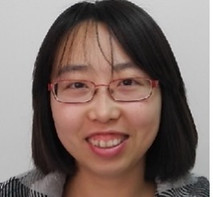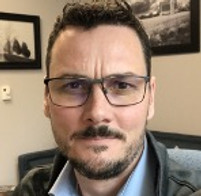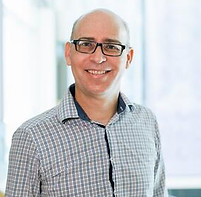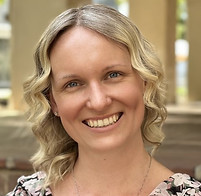Research Faculty

Chris Baddeley (Micro)
Professor, School of Chemistry, University of St Andrews (UK)
Research Interest: Use of STM, TPD and HREELS in ultrahigh vacuum to characterise the packing, orientation and thermal stability of functionalized metal surfaces for applications in corrosion inhibition and enantioselective heterogeneous catalysis.

Annie Levasseur (Macro)
Professor, Département of Construction Engineering, École de technologie supérieure
Research Interest: Environmental life cycle assessment methodology, indicators for climate change impact assessment, time aspects of climate change impacts, time aspects in life cycle assessment, environmental and techno-economic system modelling (energy, materials, etc.), climate change mitigation potential of the forest sector, environmental impacts associated with carbon capture and storage (negative emission technologies), environmental design in engineering, accounting for sustainable development in engineering projects, and environmental engineering.

Steve Holdcroft (Macro)
Professor, Department of Chemistry, Simon Fraser University
Research Interest: Electroactive organic materials and polymer films, bridging polymer synthesis, materials science, organic electronics, and electrochemistry. To understand how the structure and morphology of polymers and organic materials affects electrical, electrochemical, and optical properties to synthesize and study new materials onto which specific properties are conferred.

David Heldebrant (Macro)
Pacific Northwest National Laboratory (US)
Research Interest: Applying the principles of Green Chemistry to improve atom and energy efficiency and reduce toxicity of chemical processes and to make energy-related process more environmentally benign, with a focus on developing materials that can perform multiple tasks to reduce waste and improve energy efficiency in the fields of chemical separations and chemical conversions, applying these principles in areas of industrial gas separations, liquid/liquid separations and catalysis. Development of organic gas-separating liquids that can chemically remove CO2, SOx, and H2S from combustion, gasification or natural gas streams through applied and fundamental studies of gas absorption kinetics, thermodynamics and mechanistic studies.

James Noël (Macro)
Associate Professor, Department of Chemistry, Western University
Research Interest: To solve problems that straddle the boundaries of chemistry, physics, earth sciences, metallurgy, and materials science, especially those related to materials electrochemistry and corrosion/degradation, and safety and longevity of metallic containers for the permanent disposal of nuclear fuel waste by use of high-resolution surface analyses and precise measurements of fundamental physical chemical quantities by electrochemical and other appropriate means, and detailed data analysis, fitting, and computer modeling.

Hannu Häkkinen (Nano)
Professor, School of Chemistry, Departments of Physics and Chemistry, Nanoscience Center, University of Jyväskylä
Research Interest: Investigating physical and chemical properties of various nanosystems using computational techniques based on density functional theory, dynamical simulations and artificial intelligence. To understand physical, chemical, catalytic and bio-compatible properties of atomically precise, ligand-protected metal nanoclusters and their self-assemblies.

Tatsuya Tsukuda (Nano)
Professor, School of Chemistry, School of Science, University of Tokyo
Research Interest: Atomically-precise synthesis and characterization of metal clusters protected by ligands and their catalytic applications.

Kevin Stamplecoskie (Nano)
Assistant Professor, Department of Chemistry, Queen’s University
Research Interest: To discover new photonics materials with electronic and optical properties tuned for state-of-the-art devices. Synthesis and spectroscopy of metal clusters and larger nanomaterial with tailored properties for advanced chemical sensing, light-harvesting, biomedical imaging and fundamental studies of emerging materials.

Brian Wilson (Nano)
Professor, Department of Medical Biophysics, University of Toronto
Research Interest: Developing novel technologies and methods that can be translated to cancer patients that are based on light and nanoparticles, such as cancer detection/diagnosis and image-guided cancer interventions. Use of nanoparticles to deliver light-activatable materials to the tumor.

Marianne Koritzinsky (Nano)
Associate Professor, Department of Medical Biophysics, University of Toronto
Research Interest: Investigating the tumor microenvironment with a primary interest in understanding the cellular and molecular responses to deficiencies in oxygenation (hypoxia) and their influence on the biological behavior of tumors.

Arghya Paul (Nano)
Associate Professor, Department of Chemistry, Western University
Research Interest: Developing new class of bioctive materials, nano drug delivery vehicles and hybrid tissue regeneration matrices primarily for orthoregeneration and cardiovascular research. To innovate at the biomolecular and cellular level to develop new biomedical technologies for angiogenesis, immune-modulation and regeneration therapy; to exploit the stem cell-material interactions and mechanistic pathways; and to discover therapeutic strategies which can be translated to point-of-care patient applications

Heng-Yong Nie (Macro)
Adjunct Research Professor, Department of Physics and Astronomy, Western University
Research Interest: Exploring formation mechanisms of self-assembled monolayers (SAMs) of organophosphonic acids and organosilanes on oxides and their applications in surface engineering. Developing time-of-flight secondary ion mass spectrometry (ToF-SIMS) approaches to investigating surface/interface chemistry of organic materials. Developing atomic force microscopy (AFM) techniques for imaging additives in a polymer matrix.

Lijiu Liu (Micro)
Assistant Professor, Department of Chemistry, Western University
Research Interest: Materials synthesis and characterization of lead halide perovskites, persistent luminescent particles, and inorganic coatings for bioimplants. Electronic structure analysis using laboratory- and synchrotron-based X-ray spectroscopy techniques, including X-ray absorption fine structure (XAFS), X-ray emission spectroscopy (XES), X-ray excited optical luminescence (XEOL).

Sean Barry (Micro)
Professor, Department of Chemistry, Carleton University
Research Interest: Development of precursors and processes for atomic layer deposition (ALD); The first academic research group in Canada to work in this field. Determining the mechanism of the surface chemistry and thermal decomposition routes to better design precursors and tune the processes.

Joe Gilroy (Macro)
Associate Professor, Department of Chemistry, Western University
Research Interest: Design and synthesis of inorganic and polymeric materials with interesting optoelectronic, conducting, magnetic, and redox properties, with natural resource sustainability and alternative energy technologies in mind. Fluorescent and electro-chemiluminescent dyes containing main group elements for use in medical imaging, organic electronics, and sensing platforms. Pi-conjugated polymers incorporating inorganic elements for use in advanced sensing technologies and for charge transport/storage applications. Stable radical polymers for use as charge transport/storage materials in organic electronics.

Vera Tai (Macro)
Assistant Professor, Department of Biology, Western University
Research Interest: The diversity, evolution, and biogeography of microorganisms and elucidating their ecological roles in support of complex ecosystems or animal health. In addition to field work, I specialize in using molecular, genomics, and bioinformatics methods to investigate microbiomes from soil and aquatic environments.

Mark Biesinger (Macro)
Adjunct Research Professor, Department of Chemistry, Western University
Research Interest: XPS methodology and applications development – various areas, ToF-SIMS / Principal Component Analysis (PCA), Other surface analysis related applications

Peter McBreen (Micro)
Professor, Department of Chemistry, Laval University
Research Interest: We use surface spectroscopy and scanning tunneling microscopy to study the chemical reactivity of catalytic surfaces. Our research strives to provide a basic understanding of surface reactions at the molecular level, provides new chemical method to manipulate nanostructures and delves into the junction of organometallic and heterogeneous catalysis.

Ralf Tonner-Zech (Micro)
Professor, Department of Chemistry, University of Leipzig
Research Interest: Chemical bonding in periodic systems, Inorganic functionalization of semiconductor surfaces, Organic functionalization of surfaces, Internal interfaces, Bonding and reactivity in molecular systems, Spectroscopy and bonding in solids

Zhe She (Macro)
Assistant Professor, Department of Chemistry, Queen's University
Research Interest: Analytical/Environmental - Portable Biosensors, Probing Biological Interactions on Surfaces, Methods for Environmental Monitoring and Clinical Diagnostics; Physical - Creating Micro- and Nanostructures, Electrochemical Properties of Thin Films, Scanning Probe Microscopy Techniques

Emy Kim (Macro)
Assistant Professor, Art Conservation, Queen's University
Webpage
Research Interest: Sacrificial coatings on modern and contemporary outdoor sculpture; loss compensation and adhesion of plastics; conservation collaborations with living artists; archaeological metals.

Oana Birceanu (Nano/Macro)
Assistant Professor, Department of Physiology and Pharmacology, Western University
Webpage
Research Interest: toxicology, physiology, pharmacology, molecular biology, metabolism

J. Hugh Horton (Micro)
Professor, Department of Chemistry, Queen's University
Webpage
Research Interest: Surface Science - Atomic Force Microscopy, Chemical Force Microscopy, X-ray Photoelectron Spectroscopy, Surface IR techniques; Intermolecular Forces at Surfaces - Chiral Interactions, Polymer surface modification, Metal oxide colloids

Catherine Coolens (Nano)
Associate Professor, Department of Medical Biophysics, University of Toronto, Princess Margaret Cancer Centre
Research Interest: Biomedical imaging, cancer diagnosis and therapy, cancer mechanisms and models, image-guided therapy and device development

Farnaz Heidar-Zadeh (Nano)
Assistant Professor, Department of Chemistry, Queen's University
Webpage
Research Interest: Our research focuses on developing new mathematical tools, numerical algorithms, and computer software to qualitatively and quantitatively predict the outcome of chemical phenomena using strategies from quantum chemistry and machine learning. We are currently pursuing two main directions: 1) Adapting state-of-the-art machine-learning algorithms to develop rapid, accurate, and efficient techniques for screening large molecular databases and studying molecular dynamics simulations of chemical processes with the ultimate goal of designing molecules with desirable properties, computationally. 2) Developing rigorous mathematical definitions of empirical chemical concepts within the framework of quantum chemistry, which are then implemented in the free and open-source ChemTools software package. Our group is the lead developer of ChemTools, a collection of tools for interpreting the numerical output of quantum chemistry calculations to gain chemical insight.

James McLellan (Macro)
Professor, Department of Chemical Engineering, Queen's University
Research Interest:
-
Functional Data Analysis
-
Real-Time Optimization Using Mechanistic and Empirical Models
-
Identifiability of Process Models
-
Fault Detection Using Multivariate Statistical Techniques
-
Sensitivity Analysis
-
MITACS Project - Advanced Parameter Estimation Tools for Building Models of Chemical Processes

Michael Cunningham (Macro)
Professor, Department of Chemical Engineering, Queen's University
Research Interest: Carbon Dioxide Responsive Polymer Colloids, “Block-random” copolymers as stabilizers in emulsion polymerization, Sustainable Materials derived from Natural Polymers as Substitutes for Petroleum-Based Synthetic Polymers, CO2 Switchable Polymers for Coatings Applications, A New Approach to Making Bio-Synthetic Latexes, CO2-Triggered Agents for Forward Osmosis

Parvin Mousavi (Nano)
Director, School of Computing, Queen's University
Research Interest: Computer-aided diagnosis and interventions. These include: Machine learning techniques for in silico inference and prediction Analysis of ultrasound images and signals for enhancement of cancer detection Image-aided, computer-assisted diagnosis of disease Ultrasound-guided interventions Knowledge discovery from high throughput biological data Quantitative modeling and reverse engineering of gene regulatory networks Analysis, segmentation and classification of fluorescence microscopy images Chromosome and cell imaging.

Nicholas Mosey (Micro)
Associate Professor, Department of Chemistry, Queen's University
Research Interest: developing chemical simulation methods and using chemical simulation as a tool for gaining atomic-level insights into the properties and behaviour of molecules and materials. Our method development efforts focus on techniques for accelerating molecular dynamics simulations, developing constitutive models to describe experimental beahviour, and interpreting the changes in electronic structure that occur during reactions. Our applied research is aimed at understanding the interplay between mechanical forces and chemical reactions, with specific attention directed to the areas of tribology and electrocatalysis.

Paul Duchesne (Macro)
Assistant Professor, Department of Chemistry, Queen's University
Research Interest:
-
Heterogeneous Catalysis
-
X-ray Spectroscopy
-
Renewable Fuels

Amir Fam (Macro)
Professor, Department of Civil Engineering, Vice-Dean (Research), Engineering & Applied Science, Queen's University
Research Interest: structural engineering using fiber reinforced polymer (FRP) reinforcements and bio-based composites in new construction and retrofitting aging bridges and buildings

Richard Oleschuk (Nano)
Professor, Department of Chemistry, Queen's University
Research Interests:
Micro fluidics
-
Surface Modification, Flow Augmentation
-
Hot Embossing and Micro-molding
-
Polymeric Laboratories-on-a-chip
Mass Spectrometry
-
Protein Analysis
-
Microchip-Coupling

Lucia Lee (Nano)
Assistant Professor, Department of Chemistry, Queen's University
Research Interest: My research is inspired by the need to apply the principals of green chemistry to the emerging field of main-group supramolecular interactions (known as secondary bonding/sigma-hole interactions), with potential applications ranging from materials to medicine.

Suraj Persaud (Macro)
Assistant Professor, Department of Mechanical and Materials Engineering, Queen's University
Research Interest: Dr. Persaud’s research explores the corrosion of metals and alloys, with a specific focus on materials for nuclear power systems. The latter includes evaluating the behaviour of materials in environments relevant to current operating plants, advanced nuclear reactor designs, and solutions for nuclear waste management.

Rachel Baker (Nano)
Assistant Professor, Robins Family Professorship of Engineering Chemistry, Cross-appointed to the Department of Chemistry, Queen's University
Research Interest: Exploring the landscape of electrochemical reactions and improving process sustainability through paired synthesis

Philip Jessop (Macro)
Professor, Department of Chemistry, Queen's University
Research Interests: CO2 as a Trigger for Switchable Systems, Water/Solute Separations, Biomass Conversion and Separation

Keith Lawson (Nano)
Assistant Professor of Surgery and Medical Biophysics, University of Toronto; Division of Urology, Department of Surgery, UHN; Urologic Surgeon and Scientist, Princess Margaret Cancer Centre
Research Interests: Overcoming the solid tumor microenvironment, mapping the genetic architecture of inflammatory cell death, developing novel humanized model systems

Zhifeng Ding (Nano)
Professor, Department of Chemistry, University of Western Ontario
Research Interests: Development and applications of scanning electrochemical microscopy (SECM), Raman microspectroscopy (RMS), atomic force microscopy (AFM), electrochemiluminescence (ECL), Chemiluminescence (CL) and Radioluminescence (RL) and their combination; chemical and electrochemical preparation of luminescent nanocrystals; pharmaceutical analysis in biologic fluids, drug transfer, and ionic liquids with their reaction mechanisms and dynamics.

Taleana Huff (Micro)
Assistant Professor, Department of Chemistry, Queen's University
Research Interests: Bridging bottoms-up and top-down semiconductor manufacturing processes by understanding and optimizing molecular interactions with surfaces at the single-atom level. By leveraging state-of-the-art, atomically resolved, surface characterization techniques including scanning tunneling microscopy (STM), qPlus atomic force microscopy (AFM), and angstrom-resolved tip-enhanced Raman spectroscopy (TERS), we can achieve comprehensive electronic, structural, and chemical characterization of surface-bound molecules. This approach enables the design of tailored molecular coatings for a broad range of technological applications.

Cao Thang Ding (Nano)
Associate Professor and Canada Research Chair (Tier 2), Chemical Engineering, Queen's University
Research Interests: Renewable Fuels and Chemicals, CO2 conversion, Catalysis, Electrochemical Engineering, Energy Storage, Nanofabrication, Energy Systems




